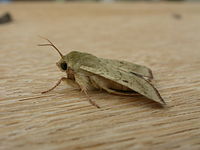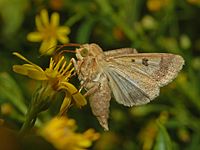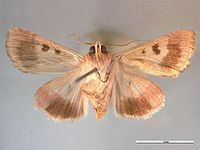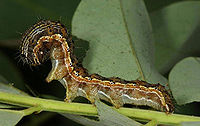- Helicoverpa armigera
-
Cotton bollworm 

Scientific classification Kingdom: Animalia Phylum: Arthropoda Class: Insecta Order: Lepidoptera Family: Noctuidae Genus: Helicoverpa Species: H. armigera Binomial name Helicoverpa armigera
(Hübner, 1805)Synonyms - Chloridea armigera Hübner,
- Chloridea obsoleta Duncan & Westwood, 1841
- Helicoverpa commoni Hardwick, 1965
- Helicoverpa obsoleta Auctorum,
- Heliothis armigera Hübner, 1805
- Heliothis conferta Walker, 1857
- Heliothis fusca Cockerell, 1889
- Heliothis pulverosa Walker, 1857
- Heliothis rama Bhattacherjee & Gupta, 1972
- Heliothis uniformis Wallengren, 1860
- Noctua armigera Hübner, [1805]
- Noctua barbara Fabricius, 1794[1]
The cotton bollworm, corn earworm or Old World (African) bollworm, Helicoverpa armigera,[1] (also known as the scarce bordered straw in the UK, where it is an immigrant[2]) is a moth, the larvae of which feed on a wide range of plants, including many important cultivated crops. It is a major pest in cotton and one of the most polyphagous and cosmopolitan pest species. It should not be confused with the similarly named related species Helicoverpa zea.
Contents
Distribution
This species is widespread in mid and south Europe, temperate Asia, Africa, Australia and Oceania. It is a migrant species, able to reach Scandinavia and other northern territories.[3]
Morphology
The cotton bollworm is very variable in both size and colour. The body length varies between twelve and twenty milimetres with a wingspan of thirty to forty milimetres. The forewings are yellowish to orange in females and greenish-gray in males, with a slightly darker transversal band in the distal third.[4] The external transversal and submarginal lines and the reniform spot are diffused. The hind wings are a pale yellow with a narrow brown band at the external edge and a dark round spot in the middle.[3]
Life cycle
The female cotton bollworm can lay several hundred eggs, distributed on various parts of the plant. Under favourable conditions, the larvae can hatch within three days and the whole life cycle can be completed in just over a month.[4]
The eggs are spherical, 0.4 to 0.6 milimetres in diameter and have a costate surface. They are white, later becoming greenish.[3]
The larvae take thirteen to twenty two days to develop, reaching up to forty milimetres long in the sixth instar. Their colouring is variable but mostly greenish and yellow to red-brown. The head is yellow with several spots. Three dark stripes extend along the dorsal side and one yellow light stripe is situated under the spiracles on the lateral side. The ventral parts of the larvae are pale.[3] They are rather aggressive, occasionally carnivorous and may even cannibalise each other. If disturbed they fall from the plant and curl up on the ground.
The pupae develop inside a silken cocoon[4] over ten to fifteen days in soil at a depth of four to ten centimetres, or in cotton bolls or maize ears.[3]
Host plants
The cotton bollworm is a highly polyphagous species. The most important crop hosts are tomato, cotton, pigeon pea, chickpea, sorghum and cowpea. Other hosts include groundnut, okra, peas, field beans, soybeans, lucerne, Phaseolus spp., other Leguminosae, tobacco, potatoes, maize, flax, Dianthus, Rosa, Pelargonium, Chrysanthemum, a number of fruit trees, forest trees and a range of vegetable crops.[1] In Russia and adjacent countries, the larvae populate more than 120 plant species, favouring Solanum, Datura, Hyoscyamus, Atriplex and Amaranthus genera.[3]
Economic significance
The greatest damage is caused to cotton, tomatoes, maize, chick peas, alfalfa and tobacco. The economic threshold of harmfulness in central Asia is three to five larvae per hundred plants of long-staple cotton and eight to twelve larvae per hundred plants on medium-staple cotton.[3] In cotton crops, blooms that have been attacked may open prematurely and stay fruitless. When the bolls are damaged, some will fall off and others will fail to produce lint or produce lint of an inferior quality. Secondary infections by fungi and bacteria are common and may lead to rotting of fruits. Injury to the growing tips of plants may disturb their development, maturity may be delayed and the fruits may be dropped.[4] Control measures include the growing of resistant varieties, weeding, inter-row cultivation, removing crop residues, deep autumn ploughing, winter watering to destroy the pupae, the use of insecticides or biological control through the release of entomophages such as Trichogramma spp. and Habrobracon hebetor. Monitoring is possible by the use of sex pheromone traps.[3]
References
External links
Categories:- Helicoverpa
- Agricultural pest insects
- Invasive animal species
Wikimedia Foundation. 2010.





